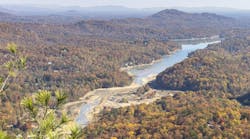Stormwater managers, particularly those in coastal areas, tend to think a lot about the “new 100-year storm,” about changing weather patterns and rising sea levels, and the need to plan differently—and size our infrastructure differently—because the weather is no longer as predictable as it once seemed.
A project now taking place in Iceland is tackling the problem from the other end. If excess carbon dioxide (CO2) in the atmosphere is causing warmer temperatures and changing weather, and if we are unable to stop releasing CO2 to the extent that we can slow or reverse the process, what are our alternatives? What if we could just get rid of the CO2—store it someplace out of sight, perhaps?
Carbon capture and storage has been researched extensively but rarely put into practice. Usually the goal is to bury the gas far beneath the surface of the earth. The problem is not only the expense of getting it there, but also the challenge of making it stay: fissures in the rock will allow it to leak and, as this article points out, the very process of drilling down deep enough to bury the gas creates new cracks and fissures.
Researchers from Southampton University in Britain are trying something a bit more permanent. A team led by Juerg Matter, a geologist, recently published a paper on changing CO2 into stone. Over millions of years, CO2 naturally bonds with certain elements, such as those in the volcanic rock basalt, and essentially removes itself from circulation. Matter’s team is trying to speed up the process, converting CO2 into stable calcite and magnesite in a matter of months, not millennia.
The team is working at a geothermal power station near Reykjavik; geothermal energy, though cleaner than some other sources, releases CO2 and hydrogen sulfide from underground. The researchers captured the exhaust from the power station, “scrubbed” it so that they had pure CO2 to work with, and then injected it, mixed with water, far below the surface into a layer of basalt. Via monitoring wells, they observed that in less than two years, 95% of the CO2 had been mineralized. They next repeated the process with unscrubbed exhaust, which is a mixture of CO2 and hydrogen sulfide. The H2S reacted with the basalt to create pyrites, so the result was equally successful at sequestering the undesirable gasses. A larger test is now underway.
In theory the process could work on a very large scale, capturing the exhaust from power stations that consume fossil fuels. One question is whether there’s enough basalt available close enough to the power stations themselves; it’s a common rock but is most prevalent on the ocean floor and in remote land regions. Still, as the article points out, if the process shows enough promise, we might build “reverse pipelines” to carry power plant exhaust to the basalt storage sites in much the same way we now create pipelines to carry natural gas to where we need it.
About the Author
Janice Kaspersen
Janice Kaspersen is the former editor of Erosion Control and Stormwater magazines.


